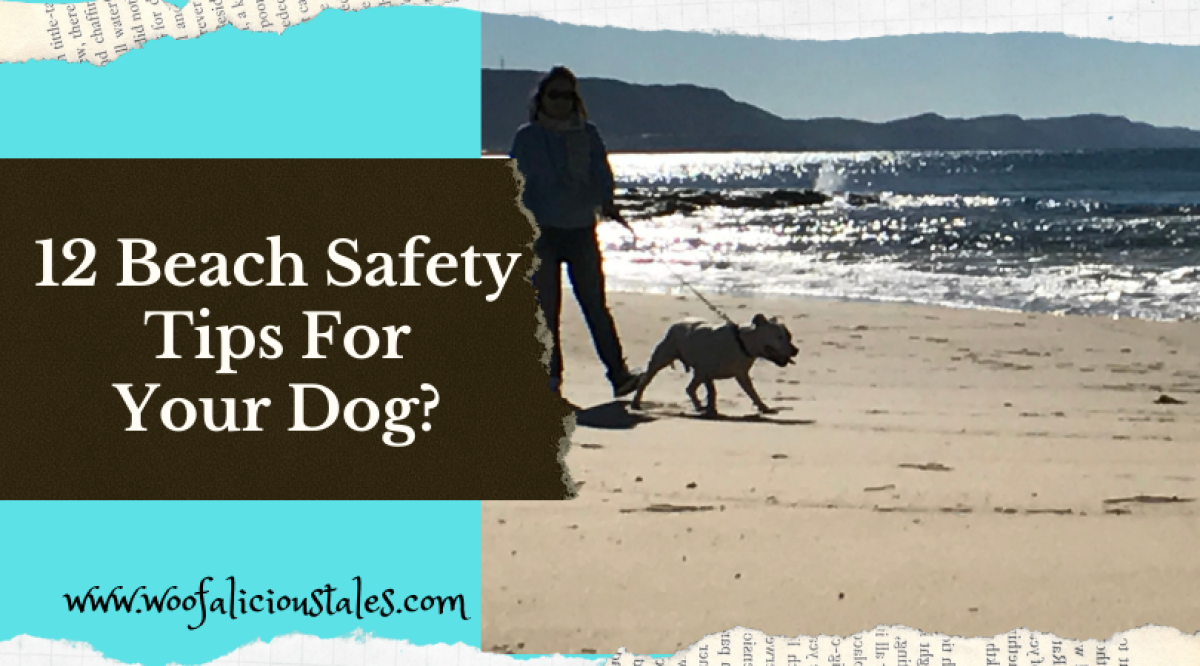12 Beach Safety Tips For Your Dog!

We had an awesome day at the beach yesterday!
It was 40 degrees and stifling hot but the ocean water was lovely to cool down in.
What I noticed was, where we were there were many dogs running around having a ball.
Inside and outside of the water all were having a blast.
One little dog was barking every time its owner entered the water. I think it thought it’s owner was going to drown : (
Everyone was having fun and all were safe.
However, there can be some dangers for our dogs at the beach that we may not even be aware of.
You think, ‘oh we’re having fun, the dogs having fun, what could go wrong?’
I hate to be the bearer of bad news, but take it all as some things to be aware of while you’re out having fun.
Don’t let it deter you from having fun with your canine buddy, just be aware.
That’s all.
BEACH SAFETY TIPS FOR YOUR DOG!
1. TAKE YOUR DOG TO A DOG BEACH!
There can be fines issued if you have your dog on a beach that dogs aren’t permitted to be on.
Make sure the beach you and your dog are on is Dog Friendly.
And find out if the dog beach allows dogs to be off leash.
We’ve found some beach permit dogs off leash at certain times of the day only.
2. HAS YOUR DOG BEEN TO THE BEACH BEFORE?
If it’s the first time you’re taking your dog to the beach, I would suggest taking them outside of the busiest times.
It can be overwhelming for some dogs.
There’s sand to discover, there’s the noise and motion of the waves and with other dogs running around or at your dog, it can become all too much.
Do a slow introduction.
If your dog doesn’t like the waves, then try around the more shallower areas first.
Don’t force your dog into the water, if they aren’t interested don’t make them go in.
AND don’t throw them in or carry them in.
Leave them be if they’re not interested.
3. PICK UP YOUR DOG’S POOP!
If your dog goes to the toilet on the beach, pick it up.
Take doggy bags with you for such an occasion.
It’s the right thing to do.
Don’t bury it in the sand for other people or dogs to unknowingly tread in.
4. IS YOUR DOG SOCIALISED?
If your dog isn’t dog friendly, do not take them to an off leash beach?
Other dogs will be running around and it will overwhelm your dog causing possible aggression.
If you want to try your dog at a beach, take them to a more secluded dog friendly one at a less busy time.
And keep them on a lead.
Have two of you with your dog.
If another dog runs towards your dog, one person walks your dog away and the other kindly shoos said dog away.
Being a dog in an exciting new environment can sometimes cause dogs to become nervous.
If your dog is excited enough to go up to another dog that feels threatend this can lead to unprovoked attack.
Although your dog is well socialised, friendly, submissive towards other dogs and ‘would never bite’ this cannot guarantee their safety or the safety of other dogs.
Having your dog on a lead or playing at an area of the beach that is a bit more quiet and less crowded will help ensure your day at the beach remains a fun and enjoyable day!
If your pet does become ill has injured themselves after a day at the beach, please contact your trusted Veterinarian immediately.
We want to keep the beaches dog friendly and everyone happy.
No dog fights.
5. DOES YOUR DOG HAVE GOOD RECALL?
Before removing your dog off their lead are you confident that if your dog runs up to other people’s beach towels or towards other dogs, that if you call them back they are going to actually come back to you??
Generally, if people are at a dog beach you can expect them to be dog people.
However, some dogs can be a bit in your face, if this is your dog, how good is their recall?
If your dog is about to do something you don’t want them to do, will they listen to you?
Just something else to bear in mind before taking your dog off their leash.
Be aware of your surroundings, is your dog going to immediately take off and not look back?
Or will they keep checking in with you to make sure you’re in eyesight to them etc?
6. BE AWARE OF OTHER CREATURES AT THE BEACH!
What I mean here are, jelly fish, blue bottles, puffer fish, crabs……….anything found at the beach really.
Dogs are curious creatures they are going to want to explore, especially around rock pools etc.
They are going to come across sea creatures.
And some of these creatures may cause them harm.
Jelly fish stingers continue reacting for weeks after the jellyfish itself dies (in other words, can still sting even when dead).
- Difficulty breathing
- Loss of coordination
- Muscle spasms
- Several stings
- Swollen oral area
- Swollen tongue
- Vomiting
Puffer Fish contain a potent neurotoxin called tetrodotoxin and when eaten affects the nerves in animals (and humans) which can lead to paralysis.
As your dog may not be seen eating the fish at the time, it is important to know the signs of toxicity any time your pet has visited the beach.
Dogs will often appear unwell after ingestion and begin constantly licking their lips and panting. Other symptoms may then start to appear.
- Nausea (drooling)
- Vomiting
- Weakness (usually starting in the legs and continuing towards the head)
- Inability to control
- Breathing issues
Treatment for this poisoning is possible, but success is more likely in pets receiving prompt and aggressive treatment by their veterinarian.
Blue Bottles – are commonly found in Australian and New Zealand waters and are often washed onto the beach after strong winds. In some instances, certain shorelines will be covered with hundreds of bluebottles which can retain the ability to sting after washing ashore.Dogs that ingest bluebottles may be stung in the mouth and throat. These stings are immediately painful and affected dogs may drool or vomit.
Stings may result in local swelling in the mouth and throat and rarely this may lead to breathing difficulties. Allergic reactions including anaphylaxis are possible.
Please be cautious whilst on the beach with your dog this summer.
Spend a few minutes inspecting the shoreline before removing your dog’s leash, particularly in the days following strong onshore winds.
If there are washed up bluebottles, keeping your dog leashed is a good idea and this can also be a useful strategy to prevent your dog eating beached pufferfish and other jellyfish.

7. YOUR DOG CAN GET HEAT STROKE!
Some of our summer days can become extremely hot.
Yesterday it was 40 degrees at the beach!
Heat stroke can be serious and if not treated quickly and intensively which can lead to organ failure and may be life threatening.
To avoid heat stroke don’t visit the beach during the hottest part of the day.
Provide yourself and your dog with enough shade, plenty of cool drinking water (not beach water) and limit excessive exercise.
If your dog is showing any of the following symptoms, they may be suffering from heat stroke, and you should seek veterinary attention immediately.
- Excessive panting
- Red (rather than pink) gums
- Diarrhoea
- Vomiting
- Lethargy (after or during a day at the beach).
8. DID YOU KNOW DOGS CAN GET SUNBURNT?
- Vomiting
- Seeming constipated
- Abdominal pain
- Loss of appetite
- Lethargy
This can lead to salt toxicity, which means there is too much sodium in the blood and is also known as hypernatremia.
The common symptoms of hypernatremia include:
- Excessive urination
- Extreme thirst
- Confusion
- Lethargy
- Diarrhoea
- Vomiting
- Nausea
- Odd behaviour
- Muscle spasms
- Seizures
- Death (in extreme cases)
To avoid your dog from ingesting too much salt water take your dog away after every 10-15 minutes and offer fresh water for them to drink.
Fishhooks commonly getting stuck in their mouth, food pipe (oesophagus), stomach or embedded in skin.
If you find that the hook and barb is embedded in an area of the body, immediately cover it to prevent further damage or your pet from chewing, licking, or swallowing it.
Even if you were able to successfully remove the hook, we would still recommend taking your dog to the veterinarian as soon as possible.
To prevent this injury from occurring always watch your dog closely when roaming the beach and remove any items that are not his toys from his mouth and discard.
WHAT DOES ALL THIS MEAN?

Related Posts
How To Keep Your Dog Cool And Safe For Summer?
Hey Woofa’s, I was starting to wonder if Summer was ever going to show…
22 January 202414 Tips on Keeping your Dog Cool this Summer!
I’m not sure what the weather is doing right now where you are but…
22 January 2024



Leave A Comment